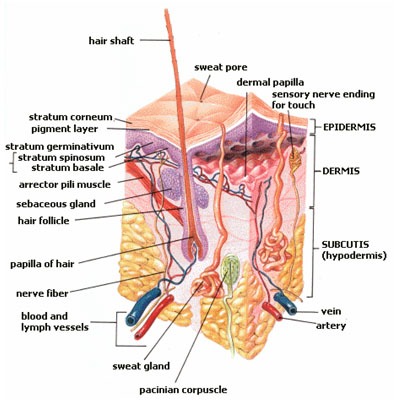- Our skin is our largest organ. The average human being has 21 sq ft of skin and about 300 million skin cells.
- Our skin performs a range of different functions which include physically protecting our bones, muscles and internal organs, protecting our bodies from outside diseases, allowing us to feel and react to heat and cold and using blood to regulate our body heat.
- The layers of mammal skin include the epidermis, dermis and subcutis.
- The outer layer of skin is the epidermis, it is found thickest on the palms of the hands and soles of the feet (around 1.5mm thick). It is thinnest on our eyelids.
- The color of human skin depends on the amount of pigment melanin that the body produces. Small amounts of melanin result in light skin while large amounts result in dark skin.
- The cells in the skin that make melanin are called melanocytes. In general, the ending -cytes or -ocytes means cells, so melanocytes are the melanin-producing cells, and hepatocytes are liver cells because hepato- means liver.
- The melanin in our melanocytes protects us from ultraviolet radiation, and this is why we tan. Darker skin comes from more melanin, so darker skinned people have better protection from sunburn and also from skin cancer.
- However, a trade-off is that vitamin D is produced in the skin after stimulation by sun exposure, and melanin slows this process down a lot. So darker skinned people need to be in the sun more each day to produce enough vitamin D.
- Here is a scientific review article about melanin and how it protects from skin cancer.
- The epidermis is made of keratinocytes, also called squamous cells, which make a protein called keratin. Keratin is a protein in our skin, hair, and nails that makes them strong and tough.
- The very outermost layer of skin is dead and cells flake off all the time. That makes the dust in our houses when enough dead cells accumulate and we can see them. The squamous cells right below that layer are making new cells to replace the ones that fall off.
- The dermis is the middle layer of the skin, and it is the thickest. The dermis contains specialized cells for regulating temperature, fighting infection, storing water, and bring blood and nutrients to the skin.
- Blood vessels bring oxygen and energy to the cells and carry vitamin D to the rest of the body
- Lymph vessels bring immune cells to the skin to fight infections
- Sweat glands release water to cool down the skin when it's hot
- Oil gland, also called sebaceous glands, secret oil to waterproof the skin and protect
- Hair follicles surround hairs and nourish them
- Sensory receptors are nerve endings that send messages to and from the brain
- Collagen is another protein that makes our skin strong and tough
- Elastin is a protein that makes our skin stretchable and rubbery
- The innermost layer of the skin is the hypodermis, also called the subcutis. It includes a lot of fat tissue that insulates the body and it also cushions and protects the internal organs of the body. Fat tissue is also called adipose tissue and extra energy is stored there.
 |
| This is basically what our pigs look like |
Next, we examined the skin of the pigs and made notations about it. Some of them had a lot of thick hair, and some had thinner hair. Some had small birthmarks on them.
We determined the gender of each pig, and there were some boys and some girls. We ran out of time before beginning to cut them, so we will make our first incision next week.


that pic is nasty!
ReplyDelete